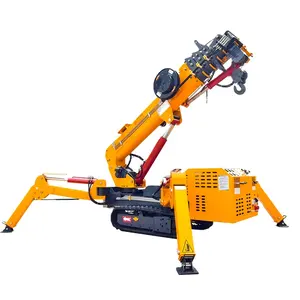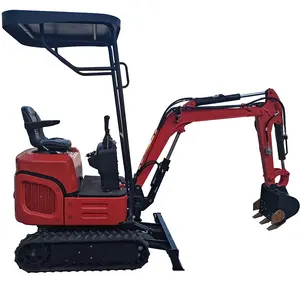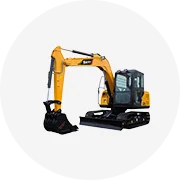Phổ biến trong ngành của bạn

Suborui 6mm 8mm 10mm 12mm 14mm Cross Carbide tip loại thép hợp kim SDS cộng với búa bê tông khoan bit cho nề bê tông đá
0,20 US$ - 0,30 US$
Đơn hàng tối thiểu: 500 Cái
Vận chuyển mỗi chiếc: 9,84 US$


Bán buôn 1 1/4 UNC M22 ướt khoan loại kim cương khoan lõi bit kim cương coring bit ướt kim cương lõi khoan bit cho bê tông
7,50 US$ - 88,59 US$
Đơn hàng tối thiểu: 10 Cái
Vận chuyển mỗi chiếc: 17,50 US$


Borui tùy chỉnh khoan bit nhà sản xuất Titan HSS 8mm M35 M2 4341 Hex Shank tác động kim loại xoắn khoan bit cho khoan kim loại
0,09 US$ - 0,10 US$
Đơn hàng tối thiểu: 500 Cái
Vận chuyển mỗi chiếc: 9,84 US$


PDC kim cương kéo khoan bit PDC khoan địa chất bit Nhỏ Gọn Kim Cương nước giếng khoan bit
80,00 US$ - 300,00 US$
Đơn hàng tối thiểu: 1 Cái
Vận chuyển mỗi chiếc: 47,33 US$


Giá tốt nhất HSS M35 co Twist jobber Khoan Bits Đối với thép không gỉ
0,06 US$ - 0,49 US$
Đơn hàng tối thiểu: 10 Cái


Deris Chất Lượng Cao Kim Cương 16 Mm Máy Cắt 9 7/8 "Pdc Bits Khoan Cho Giếng Dầu
1.896,00 US$
Đơn hàng tối thiểu: 1 Cái

HSS Hai Bước Twist Countersink Khoan Bits 3 4 5 6 7 8 9 10 12 Với Countersunk Cutter Cho Chế Biến Gỗ Công Cụ Khoan Gỗ
Sẵn sàng vận chuyển
1,73 US$ - 8,02 US$
Đơn hàng tối thiểu: 10 Cái
Vận chuyển mỗi chiếc: 1,79 US$

Tiêu Chuẩn API 9 7/8 "Iadc517 Tricone Rock Bits/Đầu Khoan Dầu Cho Đá Cứng Hình Thành
1.150,00 US$ - 1.500,00 US$
Đơn hàng tối thiểu: 1 Cái

Mũi Khoan Tricone Mũi Khoan Đá IADC435 251Mm 9 7/8 "Giá Cho Dụng Cụ Khoan Dầu
389,00 US$ - 398,00 US$
Đơn hàng tối thiểu: 1 Cái


API 9 7/8 "Kim Cương Pdc Khoan Bit/Hard Rock Máy Cắt Cho Nước Giếng
400,00 US$ - 3.000,00 US$
Đơn hàng tối thiểu: 1 Đơn vị

Nhà cung cấp tricone 9 7/8 " IADC537 tricone quay khoan
200,00 US$ - 600,00 US$
Đơn hàng tối thiểu: 1 Cái
Các danh mục hàng đầu
Giới thiệu về khoan bit 9 7 8
Tìm bền và chất lượng tốt nhất. khoan bit 9 7 8 với giá cả phải chăng chỉ có tại Alibaba.com. Để nâng cao hiệu quả và chất lượng của xi măng ,. khoan bit 9 7 8 là những phần quan trọng của thiết bị, đó là lý do tại sao bạn không được thỏa hiệp về chất lượng của chúng. Nó dán kín vỏ vào tường và toàn bộ công việc sẽ không thành công nếu vỏ chạm vào lỗ ở bất kỳ bộ phận nào.
Trên Alibaba.com, bạn có thể tìm thấy nhiều loại. khoan bit 9 7 8, là yếu tố quan trọng để đảm bảo rằng chất lượng xi măng là tối ưu. Nó làm như vậy bằng cách ngăn chặn sự xâm nhập của bùn và cách ly các khu vực không đạt tiêu chuẩn. Về cơ bản có bốn kích thước tùy thuộc vào hình dạng của chúng. Lò xo cánh cung phù hợp nhất cho giếng đứng và vì tính linh hoạt của nó, nó có thể đi qua các lỗ hẹp. Các loại cứng được làm bằng gang hoặc thanh thép, có nghĩa là chúng hoàn hảo cho một kích thước cụ thể.
Các loại bán cứng kết hợp đặc tính của lò xo cánh cung và các loại cứng. Chúng có thể được nén giống như lò xo cánh cung trong khi có lực phục hồi cao như các loại cứng. Các cánh trên khuôn được làm bằng vật liệu sợi carbon và gốm và có thể dễ dàng dán lên bề mặt vỏ. Phục hồi lực là tiêu chí quan trọng quyết định hiệu quả a. khoan bit 9 7 8 sẽ là.
Tại Alibaba.com, bạn có thể nhận được giải pháp cho mọi nhu cầu của mình ở một nơi một cách dễ dàng và nhanh chóng. Tất cả. khoan bit 9 7 8 được bán bởi những người bán, nhà sản xuất và nhà cung cấp đã được xác minh, điều này đảm bảo rằng bạn luôn nhận được sự hài lòng tối đa.
Trên Alibaba.com, bạn có thể tìm thấy nhiều loại. khoan bit 9 7 8, là yếu tố quan trọng để đảm bảo rằng chất lượng xi măng là tối ưu. Nó làm như vậy bằng cách ngăn chặn sự xâm nhập của bùn và cách ly các khu vực không đạt tiêu chuẩn. Về cơ bản có bốn kích thước tùy thuộc vào hình dạng của chúng. Lò xo cánh cung phù hợp nhất cho giếng đứng và vì tính linh hoạt của nó, nó có thể đi qua các lỗ hẹp. Các loại cứng được làm bằng gang hoặc thanh thép, có nghĩa là chúng hoàn hảo cho một kích thước cụ thể.
Các loại bán cứng kết hợp đặc tính của lò xo cánh cung và các loại cứng. Chúng có thể được nén giống như lò xo cánh cung trong khi có lực phục hồi cao như các loại cứng. Các cánh trên khuôn được làm bằng vật liệu sợi carbon và gốm và có thể dễ dàng dán lên bề mặt vỏ. Phục hồi lực là tiêu chí quan trọng quyết định hiệu quả a. khoan bit 9 7 8 sẽ là.
Tại Alibaba.com, bạn có thể nhận được giải pháp cho mọi nhu cầu của mình ở một nơi một cách dễ dàng và nhanh chóng. Tất cả. khoan bit 9 7 8 được bán bởi những người bán, nhà sản xuất và nhà cung cấp đã được xác minh, điều này đảm bảo rằng bạn luôn nhận được sự hài lòng tối đa.










